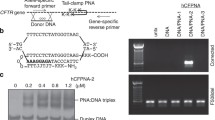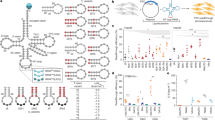Abstract
Cystic fibrosis (CF) is the most common autosomal lethal recessive disorder in the Caucasian population. The major cause of mortality is lung disease, owing to the failure of a functional protein from the cystic fibrosis transmembrane conductance regulator (CFTR) gene. Today, even though the knowledge about the CFTR genomic is extensive, no efficient treatment has been developed yet.
In this context, gene therapy represents a potential important advance on condition that it could develop efficient and safe transfection agents. Even though viral vectors have been used in most clinical trials owing to their high transfection efficiency, random integration and immunogenicity are still critical side effects. Consequently, all of these drawbacks brought forth the development of nonviral transfection systems. Although they engender few toxicity and immunogenicity problems, their low transfection efficiency is a hurdle that must be overcome. Over the past decade, we have developed an original family of monocationic lipids, cationic phosphonolipids, whose efficiency has been previously demonstrated both in vitro and in vivo.
In this report, we observe that a new cationic phosphonolipid (KLN 30) can lead to the restoration of the CFTR protein following the ex vivo transfection of epithelial cells issuing from a ΔF508 homozygous patient. The transgene expression and the cytotoxicity correlate with the charge ratio of the lipoplex. A kinetic study was performed, and a luminescent signal was detected until 35 d after transfection.
Similar content being viewed by others
References
Welsh, M. J., Tsui, L. C., Boat, T. F., and Beaudet, A. L. (1995) Cystic fibrosis. In The Metabolic and Molecular Bases of Inherited Disease (Scriver, C. R., Beaudet, A. L., Sly, W. S., and Valle, D., eds.). McGraw Hill, New York, pp. 3799–3876.
Riordan, J. R., Rommens, J. M., Kerem, B., et al. (1989) Identification of the cystic fibrosis gene: cloning and characterization of complementary DNA. Science 245, 1066–1073.
Pilewski, J. M. and Frizzell, R. A. (1999) Role of CFTR in airway disease. Physiol. Rev. 79, 215–255.
Smith, J. J., Travis, S. M., Greenberg, E. P., and Welsh, M. J. (1996) Cystic fibrosis airway epithelia fail to kill bacteria because of abnormal airway surface fluid. Cell 85, 229–236.
Pierre Charneau, Unit d’Oncologie Virale, Institut Pasteur. (2000) Available at www.pasteur.fr. Accessed January 28, 2004.
National Institutes of Health. Human gene Transfer Methods. Available at www.od.nih.gov/oba/rac/clinicaltrial.htm. Accessed January 28, 2004.
Somia, N. and Verma, I. M. (2000) Gene therapy: trials and tribulations. Nat. Rev. Genet. 1, 91–99.
Baum, C., Dullmann, J., Li, Z., et al. (2003) Side effects of retroviral gene transfer into hematopoietic stem cells. Blood. 101, 2099–2114.
Zabner, J., Couture, L. A., Gregory, R. J., Graham, S. M., Smith, A. E., and Welsh, M. J. (1993) Adenovirus-mediated gene transfer transiently corrects the chloride transport defect in nasal epithelia of patients with cystic fibrosis. Cell 75, 207–216.
Hay, J. G., McElvaney, N. G., Herena, J., and Crystal, R. G. (1995) Modification of nasal epithelial potential differences of individuals with cystic fibrosis consequent to local administration of a normal CFTR cDNA adenovirus gene transfer vector. Hum. Gene Ther. 6, 1487–1496.
Zabner, J., Ramsey, B. W., Meeker, D. P., et al. (1996) Repeat administration of an adenovirus vector encoding cystic fibrosis transmembrane conductance regulator to the nasal epithelium of patients with cystic fibrosis. J. Clin. Invest. 97, 1504–1511.
Felgner, P. L., Gadek, T. R., Holm, M., et al. (1987) Lipofection: a highly efficient, lipid-mediated DNA-transfection procedure. Proc. Natl. Acad. Sci. USA 84, 7413–7417.
McLachlan, G., Davidson, D. J., Stevenson, B. J., et al. (1995) Evaluation in vitro and in vivo of cationic liposome-expression construct complexes for cystic fibrosis gene therapy. Gene Ther. 2, 614–622.
Gill, D. R., Southern, K. W., Mofford, K. A., et al. (1997) A placebo-controlled study of liposome-mediated gene transfer to the nasal epithelium of patients with cystic fibrosis. Gene Ther. 4, 199–209.
Porteous, D. J., Dorin, J. R., McLachlan, G., et al. (1997) Evidence for safety and efficacy of DOTAP cationic liposome mediated CFTR gene transfer to the nasal epithelium of patients with cystic fibrosis. Gene Ther. 4, 210–218.
Floch, V., Audrezet, M. P., Guillaume, C., et al. (1998) Transgene expression kinetics after transfection with cationic phosphonolipids in hematopoietic non adherent cells. Biochim. Biophys. Acta. 1371, 53–70.
Floch, V., Loisel, S., Guenin, E., et al. (2000) Cation substitution in cationic phosphonolipids: a new concept to improve transfection activity and decrease cellular toxicity. J. Med. Chem. 43, 4617–4628.
Guillaume-Gable, C., Floch, V., Mercier, B., et al. (1998) Cationic phosphonolipids as nonviral gene transfer agents in the lungs of mice. Hum. Gene Ther. 9, 2309–2319.
Delepine, P., Guillaume, C., Floch, V., et al. (2000) Cationic phosphonolipids as nonviral vectors: in vitro and in vivo applications. J. Pharm. Sci. 89, 629–638.
Delepine, P., Montier, T., Guillaume, C., Vaysse, L., Le Pape, A., and Ferec, C. (2002) Visualization of the transgene distribution according to the administration route allows prediction of the transfection efficacy and validation of the results obtained. Gene Ther. 9, 736–739.
Montier, T., Cavalier, A., Delepine, P., et al. (2003) The use of in situ hybridization to study the transgene pathway following cellular transfection with cationic phosphonolipids. Blood Cells Mol. Dis. 30, 112–123.
Fajac, I., Briand, P., Monsigny, M., and Midoux, P. (1999) Sugar-mediated uptake of glycosylated polylysines and gene transfer into normal and cystic fibrosis airway epithelial cells. Hum Gene Ther. 10, 395–406.
Diebold, S. S., Kursa, M., Wagner, E., Cotten, M., and Zenke, M. (1999) Mannose polyethylenimine conjugates for targeted DNA delivery into dendritic cells. J. Biol. Chem. 274, 19,087–19,094.
Goula, D., Benoist, C., Mantero, S., Merlo, G., Levi, G., and Demeneix, B. A. (1998) Polyethylenimine-based intravenous delivery of transgenes to mouse lung. Gene Ther. 5, 1291–1295.
Li, S., Tan, Y., Viroonchatapan, E., Pitt, B. R., and Huang, L. (2000) Targeted gene delivery to pulmonary endothelium by anti-PECAM antibody. Am. J. Physiol. Lung. Cell. Mol. Physiol. 278, L504-L511.
Cavazzana-Calvo, M., Hacein-Bey, S., de Saint Basile, G., et al. (2000) Gene therapy of human severe combined immunodeficiency (SCID)-X1 disease. Science 288, 669–672.
Temme, A., Morgenroth, A., Schmitz, M., et al. (2002) Efficient transduction and long-term retroviral expression of the melanoma-associated tumor antigen tyrosinase in CD34(+) cord blood-derived dendritic cells. Gene Ther. 9, 1551–1560.
Yung, M. W., Gould, J., and Upton G. J. (2002) Nasal polyposis in children with cystic fibrosis: a long-term follow-up study. Ann. Otol. Rhinol. Laryngol. 111, 1081–1086.
Wu, R., Yankaskas, J., Cheng, E., Knowles, M. R., and Boucher, R. (1985) Growth and differentiation of human nasal epithelial cells in culture: serum-free, hormone-supplemented medium and proteoglycan synthesis. Am. Rev. Respir. Dis. 132, 311–320.
Laoukili, J., Perret, E., Willems, T., et al. (2001) IL-13 alters mucociliary differentiation and ciliary beating of human respiratory epithelial cells. Clin Invest. 108, 1817–1824.
Brezillon, S., Dupuit, F., Hinnrasky, J., et al. (1995) Decreased expression of the CFTR protein in remodeled human nasal epithelium from non-cystic fibrosis patients. Lab Invest. 72, 191–200.
Sersale, G., Casotti, V., Di Cicco, M., et al. (2001) Human respiratory cells from nasal polyps as a model for gene transfer by non-viral cationic vectors. Acta Otolaryngol. 121, 76–82.
Hart, S. L., Mayall, E., Stern, M., et al. (1995) The introduction of two silent mutations into a CFTR cDNA construct allows improved detection of exogenous mRNA in gene transfer experiments. Hum. Mol. Genet. 4, 1597–1602.
Felgner, J. H., Kumar, R., Sridhar, C. N., et al. (1994) Enhanced gene delivery and mechanism studies with a novel series of cationic lipid formulations. J. Biol. Chem. 269, 2550–2561.
Jacquot, J., Puchelle, E., Hinnrasky, J., et al. (1993) Localization of the cystic fibrosis transmembrane conductance regulator in airway secretory glands. Eur. Respir. J. 6, 169–176.
Rubenstein, R. C. and Zeitlin, P. L. (2000) Sodium 4-phenylbutyrate downregulates HSC70: implications for intracellular trafficking of ΔF508-CFTR. Am. J. Physiol. Cell Physiol. 278, 259–269.
Jensen, T. J., Loo, M. A., Pind, S., Williams, D. B., Goldberg, A. L., and Riordan, J. R. (1995) Multiple proteolytic systems, including the proteasome, contribute to CFTR processing. Cell 83, 129–135.
Felgner, P. L. and Ringold, G. M. (1989) Cationic liposome-mediated transfection. Nature 337, 387, 388.
Ono, T., Fujino, Y., Tsuchiya, T., and Tsuda, M. (1990). Plasmid DNAs directly injected into mouse brain with lipofectin can be incorporated and expressed by brain cells. Neurosci. Lett. 117, 259–263.
Son, K., and Huang, L. (1996). Factors influencing the drug sensitization of human tumor cells for in situ lipofection. Gene Ther. 3, 630–634.
Raz, E., Carson, D. A., Parker, S. E., et al. (1994). Intradermal gene immunization: the possible role of DNA uptake in the induction of cellular immunity to viruses. Proc. Natl. Acad. Sci. USA 91, 9519–9523.
Liu, Y., Mounkes, L. C., Liggit, H. D., et al. (1997). Factors influencing the efficiency of cationic liposome-mediated intravenous gene delivery. Nat. Biotechnol. 15, 167–173.
Fajac, I., Briand, P., Monsigny, M., and Midoux, P. (1999) Sugar-mediated uptake of glycosylated polylysines and gene transfer into normal and cystic fibrosis airway epithelial cells. Hum Gene Ther. 10, 395–406.
Bestor, T. H. (2000) Gene silencing as a threat to the success of gene therapy. J. Clin. Invest. 105, 409–411.
Author information
Authors and Affiliations
Corresponding author
Rights and permissions
About this article
Cite this article
Montier, T., Delépine, P., Marianowski, R. et al. CFTR transgene expression in primary ΔF508 epithelial cell cultures from human nasal polyps following gene transfer with cationic phosphonolipids. Mol Biotechnol 26, 193–205 (2004). https://doi.org/10.1385/MB:26:3:193
Issue Date:
DOI: https://doi.org/10.1385/MB:26:3:193




